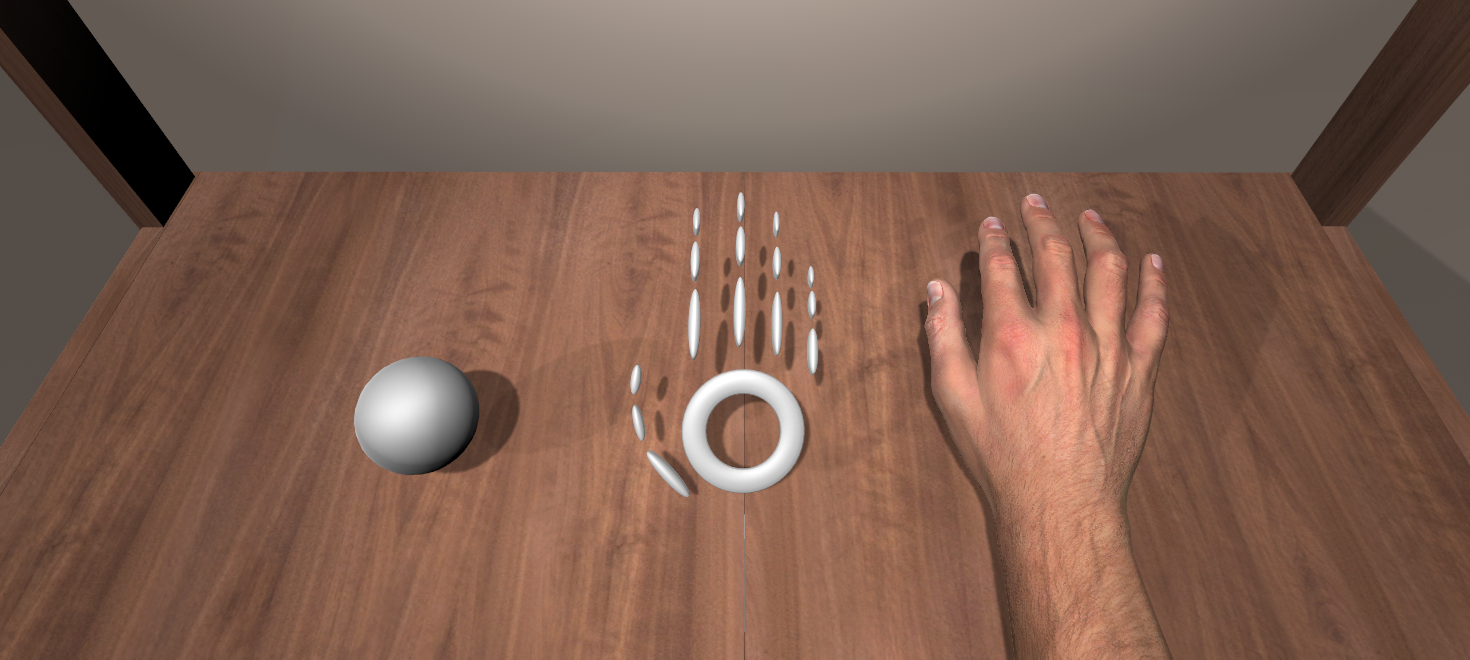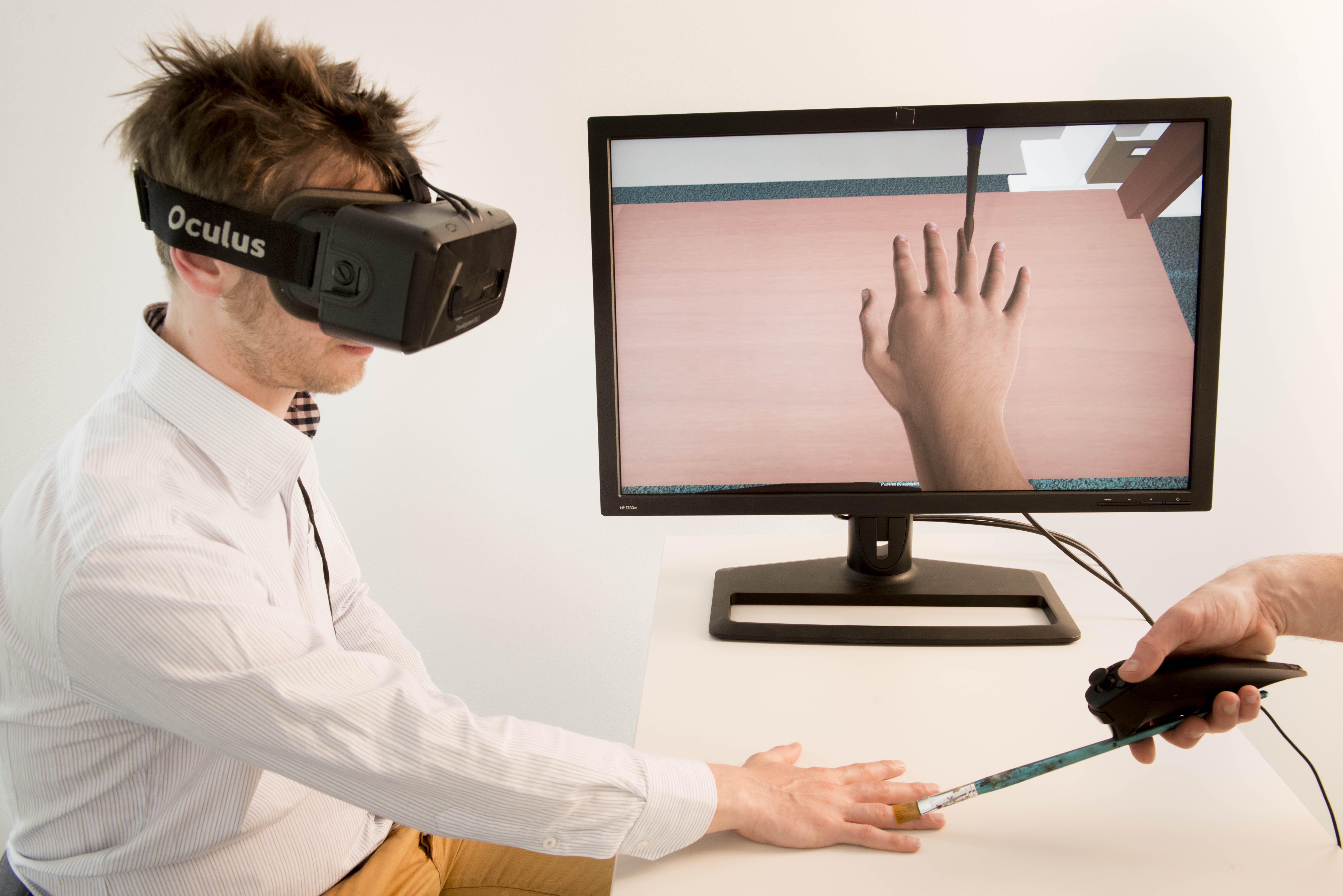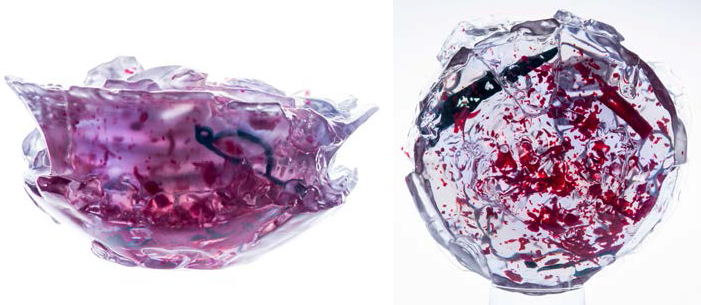Section: New Results
Virtual Reality and 3D Interaction
Perception in Virtual Environments
With the increasing demand in consumer VR applications, the need to understand how users perceive the virtual environment and their virtual self (avatar) is becoming more and more important. In particular, with the potential of virtual reality to alter and control avatars in different ways, the user representation in the virtual world does not always necessarily match the user body structure. Besides, the study of how the users perceive their surrounding environment (e.g. depth perception) is another active field of research in VR.
The role of interaction in virtual embodiment: Effects of the virtual hand representation
Participants: Ferran Argelaguet and Anatole Lécuyer
First, we have studied how people appropriate their virtual hand representation when interacting in virtual environments [14]. In order to answer this question, we conducted an experiment studying the sense of embodiment when interacting with three different virtual hand representations (see Figure 2), each one providing a different degree of visual realism but keeping the same control mechanism. The main experimental task was a Pick-and-Place task in which participants had to grasp a virtual cube and place it to an indicated position while avoiding an obstacle (brick, barbed wire or fire). Results show that the sense of agency is stronger for less realistic virtual hands which also provide less mismatch between the participant's actions and the animation of the virtual hand. In contrast, the sense of ownership is increased for the human virtual hand which provides a direct mapping between the degrees of freedom of the real and virtual hand.
This work was done in collaboration with MimeTIC team.
|
Wow! I Have Six Fingers!”: Would You Accept Structural Changes of Your Hand in VR?
Participants: Ferran Argelaguet and Anatole Lécuyer
In a different context, we have explored how users would accept as their own a six-digit realistic virtual hand [6]. By measuring participants’ senses of ownership (i.e., the impression that the virtual hand is actually our own hand) and agency (i.e., the impression to be able to control the actions of the virtual hand), we somehow evaluate the possibility of creating a Six-Finger Illusion in VR. We measured these two dimensions of virtual embodiment in a virtual reality experiment where participants performed two tasks successively: (1) a self-manipulation task inducing visuomotor feedback, where participants mimicked finger movements presented in the virtual scene and (2) a visuotactile task inspired by Rubber Hand Illusion protocols, where an experimenter stroked the hand of the user with a brush (see Figure 3). The real and virtual brushes were synchronously stroking the participants’ real and virtual hand, and in the case when the virtual brush was stroking the additional virtual digit, the real ring finger was also synchronously stroked to provide consistent tactile stimulation and elicit a sense of embodiment. Results of the experiment show that participants did experience high levels of ownership and agency of the six-digit virtual hand as a whole. These results bring preliminary insights about how avatar with structural differences can affect the senses of ownership and agency experienced by users in VR.
This work was done in collaboration with MimeTIC team.
|
CAVE Size Matters: Effects of Screen Distance and Parallax on Distance Estimation in Large Immersive Display Setups
Participants: Ferran Argelaguet and Anatole Lécuyer
When walking within a CAVE-like system, accommodation distance, parallax, and angular resolution vary according to the distance between the user and the projection walls, which can alter spatial perception. As these systems get bigger, there is a need to assess the main factors influencing spatial perception in order to better design immersive projection systems and virtual reality applications. In this work, we performed two experiments that analyze distance perception when considering the distance toward the projection screens and parallax as main factors. Both experiments were conducted in a large immersive projection system with up to 10-meter interaction space. The first experiment showed that both the screen distance and parallax have a strong asymmetric effect on distance judgments. We observed increased underestimation for positive parallax conditions and slight distance overestimation for negative and zero parallax conditions. The second experiment further analyzed the factors contributing to these effects and confirmed the observed effects of the first experiment with a high-resolution projection setup providing twice the angular resolution and improved accommodative stimuli. In conclusion, our results suggest that space is the most important characteristic for distance perception, optimally requiring about 6- to 7-meter distance around the user, and virtual objects with high demands on accurate spatial perception should be displayed at zero or negative parallax [3].
This work was done in collaboration with MimeTIC team and the University of Hamburg.
3D User Interfaces
GiAnt: stereoscopic-compliant multi-scale navigation in VEs
Participants: Ferran Argelaguet
Navigation in multi-scale virtual environments (MSVE) requires the adjustment of the navigation parameters to ensure optimal navigation experiences at each level of scale (see Figure 4). In particular, in immersive stereoscopic systems, e.g. when performing zoom-in and zoom-out operations, the navigation speed and the stereoscopic rendering parameters have to be adjusted accordingly. Although this adjustment can be done manually by the user, it can be complex, tedious and strongly depends on the virtual environment. We have proposed GiAnt (GIant/ANT) [15], a new multi-scale navigation technique which automatically and seamlessly adjusts the navigation speed and the scale factor of the virtual environment based on the user's perceived navigation speed. The adjustment ensures an almost-constant perceived navigation speed while avoiding diplopia effects or diminished depth perception due to improper stereoscopic rendering configurations. The results from the conducted user evaluation shows that GiAnt is an efficient multi-scale navigation which minimizes the changes of the scale factor of the virtual environment compared to state-of-the-art multi-scale navigation techniques.
|
Enjoying 360 Vision with the FlyVIZ
Participants: Florian Nouviale, Maud Marchal and Anatole Lécuyer
FlyVIZ is a novel concept of wearable display device which enables to extend the human field-of-view up to 360°. With the FlyVIZ users can enjoy an artificial omnidirectional vision and see "with eyes behind their back"! We propose a novel version of our approach called the FlyVIZ v2. It is based on affordable and on the shelf components. For image acquisition, the FlyVIZ v2 relies on an iPhone4S smart-phone combined with a GoPano lens that contains a curved mirror enabling the capture of video with 360 horizontal field-of-view. For image transformation, we developed a dedicated software for iPhone that processes the video stream and transforms it into a real-time meaningful representation for the user. The “FlyVIZ_v2” was demonstrated at the ACM SIGGRAPH Emerging Technologies (2016).
|
D3PART: A new Model for Redistribution and Plasticity of 3D User Interfaces
Participants: Jérémy Lacoche and Bruno Arnaldi
D3PART (Dynamic 3D Plastic And Redistribuable Technology) is a new model that we introduced to handle redistribution for 3D user interfaces. Redistribution consists in changing the components distribution of an interactive system across different dimensions such as platform, display and user. We extended previous plasticity models with redistribution capabilities, which lets developers create applications where 3D content and interaction tasks can be automatically redistributed across the different dimensions at runtime [21].
This work was done in collaboration with b<>com, ENIB and Telecom Bretagne.
Integration concept and model of Industry Foundation Classes (IFC) for interactive virtual environments
Participants: Anne-Solène Dris, Valérie Gouranton and Bruno Arnaldi
We defined a concept of Building Information Modeling (BIM) in combination with an integration model in order to enable interaction in Virtual Environments (see Figure 6). Such model, rich of information could be used to increase the level of abstraction of the interaction process. We proposed to explore and define how to create a BIM to ensure interoperability with the Industry Foundation Classes (IFC) model. The IFC model provides a definition of building objects, geometry, relation between objects, and other attributes such as layers, systems, link to planning, construction method, materials, domain (HVAC, Electrical, Architectural, Structure...) and quantities. The interoperability will enrich the virtual environment with the aim of creating an informed and interactive virtual environments, thus reducing the costs of applications' development. We defined a BIM modeling methodology extending the IFC interoperability to the interactive virtual environment [19].
|
Virtual Archaeology
Digital and handcrafting processes applied to sound-studies of archaeological bone flutes
Participants: Jean-Baptiste Barreau, Ronan Gaugne, Bruno Arnaldi and Valérie Gouranton.
Bone flutes make use of a naturally hollow raw-material. As nature does not produce duplicates, each bone has its own inner cavity, and thus its own sound-potential. This morphological variation implies acoustical specificities, thus making it impossible to handcraft a true and exact sound-replica in another bone. This phenomenon has been observed in a handcrafting context and has led us to conduct two series of experiments (the first one using a handcrafting process, the second one using a 3D process) in order to investigate its exact influence on acoustics as well as on sound-interpretation based on replicas. The comparison of the results has shed light upon epistemological and methodological issues that have yet to be fully understood. This work contributes to assessing the application of digitization, 3D printing and handcrafting to flute-like sound instruments studied in the field of archaeomusicology [26].
This work was done in collaboration with MimeTIC team, ARTeHis, LBBE and Atelier El Block.
|
Internal 3D Printing of Intricate Structures
Participants: Ronan Gaugne, Valérie Gouranton and Bruno Arnaldi.
Additive technologies are increasingly used in Cultural Heritage process, for example in order to reproduce, complete, study or exhibit artefacts. 3D copies are based on digitization techniques such as laser scan or photogrammetry. In this case, the 3D copy remains limited to the external surface of objects. Medical images based digitization such as MRI or CT scan are also increasingly used in CH as they provide information on the internal structure of archaeological material. Different previous works illustrated the interest of combining 3D printing and CT scan in order to extract concealed artefacts from larger archaeological material. The method was based on 3D segmentation techniques within volume data obtained by CT scan to isolate nested objects. This approach was useful to perform a digital extraction, but in some case it is also interesting to observe the internal spatial organization of an intricate object in order to understand its production process. We propose a method for the representation of a complex internal structure based on a combination of CT scan and emerging 3D printing techniques mixing colored and transparent parts [25], [11]. This method was successfully applied to visualize the interior of a funeral urn and is currently applied on a set of tools agglomerated in a gangue of corrosion (see Figure 8).
This work was done in collaboration with Inrap and Image ET.








